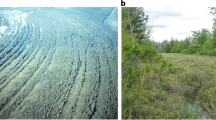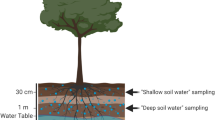Abstract
During a record drought (2006) in southwest Kansas, USA, we assessed groundwater dynamics in a shallow, unconfined aquifer, along with plant water sources and physiological responses of the invasive riparian shrub Tamarix ramosissima. In early May, diel water table fluctuations indicated evapotranspirative consumption of groundwater by vegetation. During the summer drought, the water table elevation dropped past the lowest position previously recorded. Concurrent with this drop, water table fluctuations abruptly diminished at all wells at which they had previously been observed despite increasing evapotranspirative demand. Following reductions in groundwater fluctuations, volumetric water content declined corresponding to the well-specific depths of the capillary fringe in early May, suggesting a switch from primary dependence on groundwater to vadose-zone water. In at least one well, the fluctuations appear to re-intensify in August, suggesting increased groundwater uptake by Tamarix or other non-senesced species from a deeper water table later in the growing season. Our data suggest that Tamarix can rapidly shift water sources in response to declines in the water table. The use of multiple water sources by Tamarix minimized leaf-level water stress during drought periods. This study illustrates the importance of the previous hydrologic conditions experienced by site vegetation for controlling root establishment at depth and demonstrates the utility of data from high-frequency hydrologic monitoring in the interpretation of plant water sources using isotopic methods.






Similar content being viewed by others
References
Allen RG, Pereira LS, Raes D, Smith M (1998) Crop evapotranspiration—guidelines for computing crop water requirements. FAO Irrigation and Drainage Paper 56. Food and Agricultural Organization of the United Nations, Rome
Alley RB et al (2007) Climate change 2007: the physical science basis, summary for policy makers. IPCC Secretariat, Geneva, Switzerland
Anderson JE (1982) Factors controlling transpiration and photosynthesis in Tamarix chinensis Lour. Ecology 63:48–56
Barnett TP et al (2008) Human-induced changes in the hydrology of the Western United States. Science 319:1080–1083
Busch DE, Smith SD (1995) Mechanisms associated with the decline of woody species in riparian ecosystems of the southwestern United States. Ecol Monogr 65:347–370
Busch DE, Ingraham NL, Smith SD (1992) Water uptake in woody riparian phreatophytes of the southwestern United States: a stable isotope study. Ecol Appl 2:450–459
Butler JJ Jr, Whittemore DO, Kluitenberg GJ (2005) Ground water assessment in association with salt cedar control—report on year one activities. Kansas Geological Survey open-file report, 2005-19. Kansas Geological Survey
Butler JJ Jr et al (2007) A field investigation of phreatophyte-induced fluctuations in the water table. Water Resour Res 43:W02404. doi:10.1029/2005WR004627
Butler JJ Jr, Kluitenberg GJ, Whittemore DO (2008) Ground water assessment in association with salt cedar control—report on phase two activities. Kansas Geological Survey open-file report 2008-13. Kansas Geological Survey
Chapin FS et al (2000) Consequences of changing biodiversity. Nature 405:234–242
Cleverly JR, Smith SD, Sala A, Devitt DA (1997) Invasive capacity of Tamarix ramosissima in a Mojave Desert floodplain: the role of drought. Oecologia 111:12–18
Cleverly JR, Dahm CN, Thibault JR, McDonnell DE, Coonrod JEA (2006) Riparian ecohydrology: regulation of water flux from the ground to the atmosphere in the Middle Rio Grande, New Mexico. Hydrol Process 20:3207–3225
Crall AW et al (2006) Show me the numbers: what data currently exist for non-native species in the USA? Front Ecol Environ 4:414–418
Davis MA et al (2005) Vegetation change: a reunifying concept in plant ecology. Perspect Plant Ecol Evol Syst 7:69–76
Devitt DA, Piorkowski JM, Smith SD, Cleverly JR, Sala A (1997) Plant water relations of Tamarix ramosissima in response to the imposition and alleviation of soil moisture stress. J Arid Environ 36:527–540
Di Tomaso JM (1998) Impact, biology, and ecology of saltcedar (Tamarix spp.) in the southwestern United States. Weed Technol 12:326–336
Dukes JS, Mooney HA (1999) Does global change increase the success of biological invaders? Trends Ecol Evol 14:135–139
Easterling DR, Meehl GA, Parmesan C, Changnon SA, Karl TR, Mearns LO (2000) Climate extremes: observations, modeling, and impacts. Science 289:2068–2074
Ehleringer JR, Osmond CB (1989) Stable isotopes. In: Pearcy RW, Ehleringer JR, Mooney HA, Rundel PW (eds) Plant physiological ecology field methods and instrumentation. Chapman and Hall, London, pp 281–300
Epstein S, Mayeda T (1953) Variation of 18O content of waters from natural sources. Geochim Cosmochim Acta 4:213–224
Fenner P, Brady WW, Patten DR (1984) Effects of regulated water flows on regeneration of Fremont cottonwood. J Range Manage 38:135–138
Friedman JM et al (2005) Dominance of non-native riparian trees in western USA. Biol Invasions 7:747–751
Gardner WR, Hillel DI (1962) The relation of external evaporative conditions to the drying of soils. J Geophys Res 67:4319–4325
Glenn EP, Nagler PL (2005) Comparative ecophysiology of Tamarix ramosissima and native trees in western US riparian zones. J Arid Environ 61:419–446
Gries D et al (2003) Growth and water relations of Tamarix ramosissima and Populus euphratica on Taklamakan desert dunes in relation to depth to a permanent water table. Plant Cell Environ 26:725–736
Horton JL, Clark JL (2001) Water table decline alters growth and survival of Salix gooddingii and Tamarix chinensis seedlings. For Ecol Manage 140:239–247
Horton JL, Kolb TE, Hart SC (2001) Physiological response to groundwater depth varies among species and with river flow regulation. Ecol Appl 11:1046–1059
Horton JL, Hart SC, Kolb TE (2003) Physiological condition and water source use of Sonoran Desert riparian Trees at the Bill Williams River, Arizona, USA. Isot Health Environ Stud 39:69–82
Huntington TG (2006) Evidence for intensification of the global water cycle: review and synthesis. J Hydrol 319:83–95
IPCC (2001) Climate change 2001: synthesis report. In: Watson RT, Core Writing Team (eds) A contribution of Working Groups I, II, and III to the third assessment report of the Intergovernmental Panel on Climate Change. Cambridge University Press, Cambridge
Jasper K, Calanca P, Fuhrer J (2006) Changes in summertime soil water patterns in complex terrain due to climatic change. J Hydrol 327:550–563
Jenerette GD, Larsen L (2006) A global perspective on changing sustainable urban water supplies. Glob Planet Change 50:202–211
Karl TR, Trenberth KE (2003) Modern global climate change. Science 302:1719–1723
Labat D, Goddéris Y, Probst JL, Guyot JL (2004) Evidence for global runoff increase related to climate warming. Adv Water Resour 27:631–642
Larcher W (1995) Physiological plant ecology, 3rd edn. Springer, Berlin, pp 85–86
Loheide SP, Butler JJ, Gorelick SM (2005) Estimation of groundwater consumption by phreatophytes using diel water table fluctuations: a saturated–unsaturated flow assessment. Water Resour Res 41:W07030. doi:10.1029/2005WR003942
Moore GW, Cleverly JR, Owens MK (2008) Nocturnal transpiration in riparian Tamarix thickets authenticated by sap flux, eddy covariance and leaf gas exchange measurements. Tree Physiol 28:521–528
Mounsif M, Wan C, Sosebee RE (2002) Effects of top-soil drying on saltcedar photosynthesis and stomatal conductance. J Range Manage 55:88–93
Nagler PL, Scott RL, Westenburg C, Cleverly JR, Glenn EP, Huete AR (2005) Evapotranspiration on western US rivers estimated using the enhanced vegetation index from MODIS and data from eddy covariance and Bowen ratio flux towers. Remote Sens Environ 97:337–351
Naumburg E, Mata-Gonzalez R, Hunter RG, McLendon T, Martin DW (2005) Phreatophytic vegetation and groundwater fluctuations: a review of current research and application of ecosystem response modelling with an emphasis on Great Basin vegetation. Environ Manage 35:726–740
Newman BD et al (2006) Ecohydrology of water-limited environments: a scientific vision. Water Resour Res 42:W06302
Nippert JB, Knapp AK (2007) Linking water uptake with rooting patterns in grassland species. Oecologia 153:261–272
Oki T, Kanae S (2006) Global hydrological cycles and world water resources. Science 313:1068–1072
Pataki DE, Bush SE, Gardner P, Solomon DK, Ehleringer JR (2005) Ecohydrology in a Colorado River riparian forest: implications for the decline of Populus fremontii. Ecol Appl 15:1009–1018
Pimentel D et al (2004) Water resources: agricultural and environmental issues. Bioscience 54:909–918
Pockman WT, Sperry JS (2000) Vulnerability to xylem cavitation and the distribution of Sonoran desert vegetation. Am J Bot 87:1287–1299
Reich PB, Hinckley TM (1989) Influence of pre-dawn water potential and soil-to-leaf hydraulic conductance on maximum daily leaf diffusive conductance in two oak species. Funct Ecol 3:719–726
Sala A, Smith SD, Devitt DA (1996) Water use by Tamarix ramosissima and associated phreatophytes in a Mojave Desert floodplain. Ecol Appl 6:888–898
Scott ML, Lines GC, Auble GT (2000) Channel incision and patterns of cottonwood stress and mortality along the Mojave River, California. J Arid Environ 44:399–414
Shafroth PB, Stromberg JC, Patten DT (2000) Woody riparian vegetation response to different alluvial water table regimes. West N Am Nat 60:66–76
Shafroth PB, Stromberg JC, Patten DT (2002) Riparian vegetation response to altered disturbance and stress regimes. Ecol Appl 12:107–123
Shafroth PB et al (2005) Control of Tamarix in the Western United States: implications for water salvage, wildlife use, and riparian restoration. Environ Manage 35:231–246
Stromberg JC et al (2007) Altered stream-flow regimes and invasive plant species: the Tamarix case. Glob Ecol Biogeogr 16:381–393
VanLooy JA, Martin CW (2005) Channel and vegetation change on the Cimarron River, southwestern Kansas, 1953–2001. Ann Assoc Am Geogr 95:727–739
White WN (1932) A method of estimating ground-water supplies based on discharge by plants and evaporation from soil—results of investigations in Escalante Valley, Utah, U.S. Geological Survey water supply paper 659-A. U.S. Geological Survey
Xu H, Li Y, Xu GQ, Zou T (2007) Ecophysiological response and morphological adjustment of two Central Asian desert shrubs towards variation in summer precipitation. Plant Cell Environ 30:399–409
Zavaleta ES (2000) Valuing ecosystem services lost to Tamarix invasion in the United States. In: Mooney H, Hobbs RJ (eds) Invasive species in a changing world. Island Press, Washington, DC, pp 261–302
Acknowledgments
We thank L. González, A. Heitman, and M. Knapp for analytical assistance, and C. Springer, S. Hudman, A. Knapp, R. Borchert, Z. Cardon and two anonymous reviewers for reviews of earlier versions of this manuscript. This research was supported in part by the Kansas Geological Survey (KGS) at the University of Kansas, the Kansas Water Resources Institute, the Kansas Water Office, and the Kansas Alliance of Wetlands and Streams. Postdoctoral support for J. B. Nippert was provided by the National Science Foundation (IOS-0517668), the University of Kansas EEB General Research Fund, and the KGS.
Author information
Authors and Affiliations
Corresponding author
Additional information
Communicated by Zoe Cardon.
Rights and permissions
About this article
Cite this article
Nippert, J.B., Butler, J.J., Kluitenberg, G.J. et al. Patterns of Tamarix water use during a record drought. Oecologia 162, 283–292 (2010). https://doi.org/10.1007/s00442-009-1455-1
Received:
Accepted:
Published:
Issue Date:
DOI: https://doi.org/10.1007/s00442-009-1455-1




